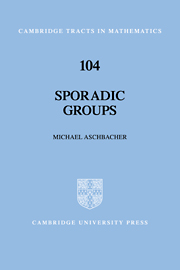2 - 2-Structure in Finite Groups
Published online by Cambridge University Press: 04 August 2010
Summary
In this chapter we record some facts about the 2-subgroups of finite groups. In particular in Section 7 we recall some standard facts about involutions; that is, elements of order 2. Then in Section 8 we consider so-called large extraspecial 2-subgroups of a finite group G. Most of the sporadic groups contain such subgroups. They will serve as an important tool both in analyzing the structure of the sporadic groups and as part of the hypotheses under which we characterize many of the sporadics. See Chapter 5 for an idea of how this goes.
Involutions
In this section G is a finite group. Recall that an involution in G is an element of order 2. The following elementary result appears as 45.2 in [FGT]:
Lemma 7.1:Let x and y be distinct involutions in G, n = |xy|, and D = 〈x,y〈. Then
(1) D is a dihedral group D2n of order 2n.
(2) Each element in D – 〈xy〈 is an involution.
(3) If n is odd then D is transitive on its involutions, so in particular x is conjugate to y in D.
(4) If n is even then each involution in G is conjugate to exactly one of x, y, or z, where z is the unique involution in 〈xy〈. Further z ∈ Z(D).
(5) If n is even and z is the involution in 〈xy〈 then xz is conjugate to x in D if and only if n ≡ 0 mod 4.
- Type
- Chapter
- Information
- Sporadic Groups , pp. 18 - 34Publisher: Cambridge University PressPrint publication year: 1994

